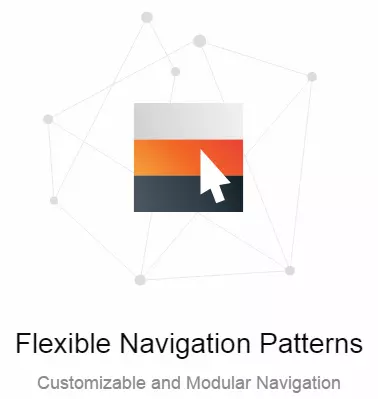Foundation 6's streamlined menu system: A single, adaptable component replacing multiple legacy options.
Key Improvements:
- Unified Menu Component: Foundation 6 consolidates inline lists, side navigation, icon bars, and sub-navigation into a single, highly customizable "Menu" component. This simplifies development and reduces framework size.
- Responsive Design: Create menus that adapt dynamically across different screen sizes and devices using a single codebase. This eliminates the need for separate menus for desktop and mobile.
- JavaScript Plugins: Enhance functionality with plugins like dropdown, drilldown, and accordion menus, all accessible via keyboard navigation.
- Lightweight Framework: The merging of menu structures has resulted in a significant reduction in framework size (over 1000 lines of CSS removed), leading to faster loading times and easier maintenance.
- Top Bar Enhancements: The Top Bar component now supports left and right sections for menus and includes a responsive toggle for smaller screens.

Building Menus in Foundation 6:
The core menu structure is straightforward: a <code><ul></ul> element with the class menu, containing <code><li> items and <a></a> tags for links. Additional classes control the menu's appearance and behavior.
-
Simple Menus: Use the
.simpleclass to remove default styling and create a completely custom look. -
Horizontal/Vertical Menus: The default is horizontal. Add the
.verticalclass for vertical orientation. -
Nested Menus (Submenus): Use nested
<code><ul></ul>elements with the.nestedclass for submenus within vertical menus. For more complex interactions, use the dropdown, drilldown, or accordion plugins. -
Icon Menus: Incorporate icons using
<i class="fi-..."></i>elements (using Foundation's icon font) or image tags within the<a></a>tags. The.icon-topclass positions icons above menu text. -
Dropdown, Drilldown, and Accordion Menus: These JavaScript-powered plugins offer dynamic, interactive menus. Use the
data-dropdown-menu,data-drilldown, anddata-accordion-menuattributes respectively to enable these features. Event handling allows for custom actions (e.g.,up.zf.accordionfor accordion closure). -
Responsive Navigation: Use the
data-responsive-menuattribute to define different menu types for various screen sizes (e.g.,small-dropdown,medium-drilldown). -
Top Bar with Left/Right Sections: Use the
.top-bar-leftand.top-bar-rightclasses within the.top-barcontainer to create menus with sections on both sides. The responsive toggle (data-responsive-toggle) displays a menu button on smaller screens.
Example (Simple Horizontal Menu):
<ul class="menu"> <li><a href="http://miracleart.cn/link/93ac0c50dd620dc7b88e5fe05c70e15b">Option 1</a></li> <li><a href="http://miracleart.cn/link/93ac0c50dd620dc7b88e5fe05c70e15b">Option 2</a></li> <li><a href="http://miracleart.cn/link/93ac0c50dd620dc7b88e5fe05c70e15b">Option 3</a></li> </ul>
Conclusion:
Foundation 6's redesigned menu system offers a significant improvement in both functionality and ease of use. The unified approach simplifies development, reduces code size, and enhances responsiveness, making it a powerful tool for building modern, flexible websites.
The above is the detailed content of Foundation 6: The New Menu Component. For more information, please follow other related articles on the PHP Chinese website!

Hot AI Tools

Undress AI Tool
Undress images for free

Undresser.AI Undress
AI-powered app for creating realistic nude photos

AI Clothes Remover
Online AI tool for removing clothes from photos.

Clothoff.io
AI clothes remover

Video Face Swap
Swap faces in any video effortlessly with our completely free AI face swap tool!

Hot Article

Hot Tools

Notepad++7.3.1
Easy-to-use and free code editor

SublimeText3 Chinese version
Chinese version, very easy to use

Zend Studio 13.0.1
Powerful PHP integrated development environment

Dreamweaver CS6
Visual web development tools

SublimeText3 Mac version
God-level code editing software (SublimeText3)

Hot Topics
 What is 'render-blocking CSS'?
Jun 24, 2025 am 12:42 AM
What is 'render-blocking CSS'?
Jun 24, 2025 am 12:42 AM
CSS blocks page rendering because browsers view inline and external CSS as key resources by default, especially with imported stylesheets, header large amounts of inline CSS, and unoptimized media query styles. 1. Extract critical CSS and embed it into HTML; 2. Delay loading non-critical CSS through JavaScript; 3. Use media attributes to optimize loading such as print styles; 4. Compress and merge CSS to reduce requests. It is recommended to use tools to extract key CSS, combine rel="preload" asynchronous loading, and use media delayed loading reasonably to avoid excessive splitting and complex script control.
 External vs. Internal CSS: What's the Best Approach?
Jun 20, 2025 am 12:45 AM
External vs. Internal CSS: What's the Best Approach?
Jun 20, 2025 am 12:45 AM
ThebestapproachforCSSdependsontheproject'sspecificneeds.Forlargerprojects,externalCSSisbetterduetomaintainabilityandreusability;forsmallerprojectsorsingle-pageapplications,internalCSSmightbemoresuitable.It'scrucialtobalanceprojectsize,performanceneed
 Does my CSS must be on lower case?
Jun 19, 2025 am 12:29 AM
Does my CSS must be on lower case?
Jun 19, 2025 am 12:29 AM
No,CSSdoesnothavetobeinlowercase.However,usinglowercaseisrecommendedfor:1)Consistencyandreadability,2)Avoidingerrorsinrelatedtechnologies,3)Potentialperformancebenefits,and4)Improvedcollaborationwithinteams.
 CSS Case Sensitivity: Understanding What Matters
Jun 20, 2025 am 12:09 AM
CSS Case Sensitivity: Understanding What Matters
Jun 20, 2025 am 12:09 AM
CSSismostlycase-insensitive,butURLsandfontfamilynamesarecase-sensitive.1)Propertiesandvalueslikecolor:red;arenotcase-sensitive.2)URLsmustmatchtheserver'scase,e.g.,/images/Logo.png.3)Fontfamilynameslike'OpenSans'mustbeexact.
 What is Autoprefixer and how does it work?
Jul 02, 2025 am 01:15 AM
What is Autoprefixer and how does it work?
Jul 02, 2025 am 01:15 AM
Autoprefixer is a tool that automatically adds vendor prefixes to CSS attributes based on the target browser scope. 1. It solves the problem of manually maintaining prefixes with errors; 2. Work through the PostCSS plug-in form, parse CSS, analyze attributes that need to be prefixed, and generate code according to configuration; 3. The usage steps include installing plug-ins, setting browserslist, and enabling them in the build process; 4. Notes include not manually adding prefixes, keeping configuration updates, prefixes not all attributes, and it is recommended to use them with the preprocessor.
 What are CSS counters?
Jun 19, 2025 am 12:34 AM
What are CSS counters?
Jun 19, 2025 am 12:34 AM
CSScounterscanautomaticallynumbersectionsandlists.1)Usecounter-resettoinitialize,counter-incrementtoincrease,andcounter()orcounters()todisplayvalues.2)CombinewithJavaScriptfordynamiccontenttoensureaccurateupdates.
 CSS: When Does Case Matter (and When Doesn't)?
Jun 19, 2025 am 12:27 AM
CSS: When Does Case Matter (and When Doesn't)?
Jun 19, 2025 am 12:27 AM
In CSS, selector and attribute names are case-sensitive, while values, named colors, URLs, and custom attributes are case-sensitive. 1. The selector and attribute names are case-insensitive, such as background-color and background-Color are the same. 2. The hexadecimal color in the value is case-sensitive, but the named color is case-sensitive, such as red and Red is invalid. 3. URLs are case sensitive and may cause file loading problems. 4. Custom properties (variables) are case sensitive, and you need to pay attention to the consistency of case when using them.
 Case Sensitivity in CSS: Selectors, Properties, and Values Explained
Jun 19, 2025 am 12:38 AM
Case Sensitivity in CSS: Selectors, Properties, and Values Explained
Jun 19, 2025 am 12:38 AM
CSSselectorsandpropertynamesarecase-insensitive,whilevaluescanbecase-sensitivedependingoncontext.1)Selectorslike'div'and'DIV'areequivalent.2)Propertiessuchas'background-color'and'BACKGROUND-COLOR'aretreatedthesame.3)Valueslikecolornamesarecase-insens






